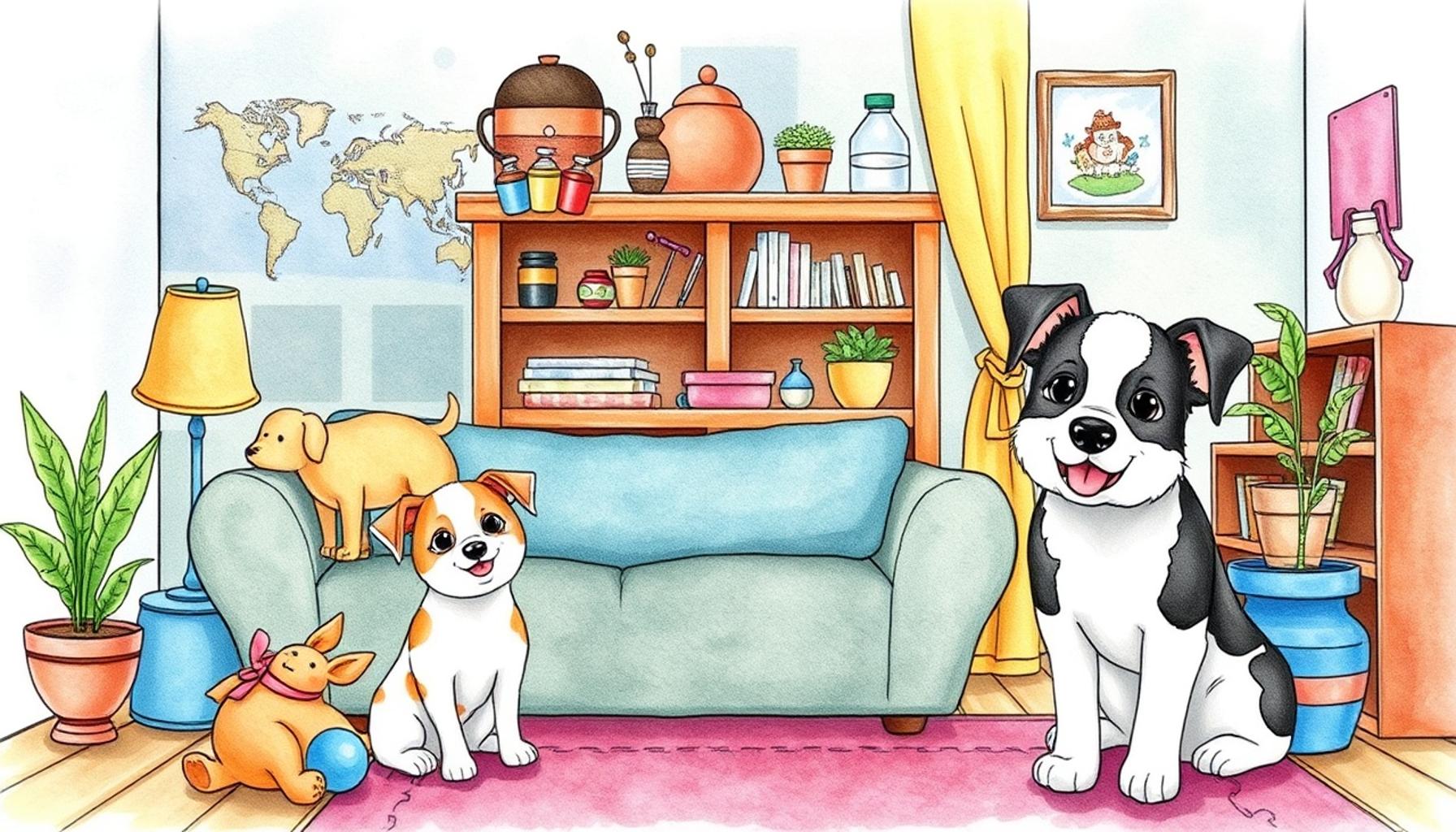How to Prepare Your Home for a New Pet: Tips and Resources for Adoption

Exciting Journey with a New Pet
Bringing a new pet into your home is an exhilarating step that not only adds joy and companionship to your daily life but also enhances your emotional well-being. Nonetheless, it mandates meticulous planning to guarantee a seamless transition for everyone involved—especially your new furry friend. Understanding how to prepare your home for a new pet is paramount in creating a safe and nurturing environment.
Essential Preparations
When embarking on this new adventure, consider the following key elements in your preparation:
- Safety First: Before welcoming your new companion, it’s crucial to eliminate potential hazards within your home. This includes removing toxic plants like Oleander and Sago Palm, concealing electrical cords that a curious pet may chew on, and ensuring small objects such as coins or plastic wrappers are out of reach to prevent choking hazards. For a more pet-friendly home, consider installing baby gates or securing heavy objects that could tip over.
- Comfort Zone: Every pet should have a designated space that feels like home. Prepare a cozy corner with a comfortable bed, preferably in a quiet area, along with toys that can provide both entertainment and mental stimulation. Ensure that food bowls are placed in a calm, accessible spot where your pet can dine peacefully. Appropriate pacing here is crucial; allow your new friend some time to adjust to their surroundings.
- Supplies and Resources: Stocking up on essentials is vital for the well-being of your new pet. Consider purchasing high-quality pet food, grooming tools, and health care items like flea treatments or vaccines. If you are unsure where to begin, local adoption centers can be invaluable resources, offering guides tailored to various pet types and needs.
The Growing Culture of Pet Adoption in Nigeria
In Nigeria, the culture of pet ownership is rapidly evolving, with more individuals and families embracing the joy of adopting pets. Take for instance the rising popularity of dogs like the Nigerian Local Breed, which adapts well to the milieu of many Nigerian homes. Each type of pet may bring its unique demands, so understanding these breeds and their requirements is integral to ensuring their well-being. Whether you’re looking after a playful puppy or an affectionate kitten, an informed approach can significantly ease their adjustment and integration into your home.
As individuals embark on this journey, it’s crucial to remain aware that each pet possesses a distinctive personality and quirks, thus enriching the household experience. By preparing thoughtfully for their arrival and familiarizing yourself with the resources available for adoption, you’re not merely gaining a pet; you’re welcoming a lifelong companion who will bring joy, loyalty, and love into your life.
RECOMMENDED: Check out this similar article

Creating a Welcoming Environment
As you gear up to welcome a new pet, your home environment becomes pivotal in ensuring a smooth transition. An inviting space tailored to your new companion’s needs can significantly enhance their comfort and settle their nerves. Here’s how to create that warm, welcoming environment:
Understanding Your New Companion
The first step to preparing your home is to fully understand the type of pet you will be adopting. Each animal—be it a dog, cat, rabbit, or bird—has its distinct needs and behaviors. Research and familiarize yourself with the specific requirements of the breed or species. For instance, while dogs generally thrive on companionship and require regular exercise, cats may appreciate vertical spaces and comfortable hideouts. Knowing these aspects can help you design your home appropriately to cater to these unique needs.
Setting Up Your Space
Once you’ve equipped yourself with knowledge, it’s time to set up your space. Consider the following essentials to ensure a welcoming environment:
- Pet-Proofing: In addition to removing hazards, think about installing safety features such as window screens to prevent accidental falls and secure doors to avoid escape.
- Designated Areas: Create specific zones for eating, sleeping, and playing. This not only gives the pet structure but also helps in managing behaviors. A quiet corner for a bed and a play area with safe toys can promote relaxation and entertainment.
- Accessibility: Ensure that food and water bowls are positioned at medium height to reduce strain on your pet’s neck. If you’re considering a larger dog, opt for elevated bowls which can promote better digestion.
- Social Spaces: Pets thrive on interactions, so allocate spaces for bonding activities, whether it’s a cozy couch for cuddling or an outdoor area for play. This fosters a strong connection right from the get-go.
- Adoption Resources: Local animal shelters and adoption centers frequently offer resources and workshops on how to best prepare for pet ownership. Don’t hesitate to tap into these; they often provide crucial information that aligns with the needs of different pets.
Finding the Right Supplies
Once your home is ready, it’s time to gather the necessary supplies that will support your new pet’s health and happiness. Begin with must-haves such as a suitable ID collar, leash, and microchip (if applicable), followed by appropriate food bowls, quality pet food, a litter box for cats, and grooming supplies. Budgeting for unexpected expenses, such as veterinary visits or a pet emergency fund, is also wise, as these can arise unexpectedly in the journey of pet ownership.
In Nigeria, with an increasing number of pet supply stores and online platforms, accessing these essentials has become more convenient. Engaging with local pet owner communities can also provide recommendation and support, enhancing your preparation process.
Overall, careful planning and understanding the needs of your new pet will set the stage for a joyful companionship. By creating a loving and prepared environment, you are not just providing a space; you are crafting a home filled with love and adventure.
Creating a Safe and Comfortable Space
When bringing a new pet into your home, it’s essential to create a dedicated space that is both safe and welcoming for them. This area should be quiet and free from unnecessary distractions. Here are some tips to consider:1. Designate a Pet Zone: Choose a corner or a room where your pet can feel secure. This should be their personal space, equipped with a bed, toys, and food and water bowls.2. Pet-Proofing Your Home: Before the big day, thoroughly check your home for potential hazards. Remove toxic plants, secure cords, and keep small items out of reach. This precaution will help prevent accidents and keeps your curious pet safe.3. Comfort Items: Familiarize your pet with their new environment by providing comfort items. A blanket with the scent of their previous home can help ease their anxiety during the transition.4. Establish Routines: Pets thrive on routine. Set consistent feeding times and daily exercise schedules to help your new companion adjust.5. Introduce Family Gradually: Allow your pet to acclimate to one family member at a time. This process minimizes overwhelming stress during their adjustment phase.These steps can help create a nurturing environment, making it easier for your new furry friend to adjust while also enhancing the bond between you and your pet.
Resource Centers for Adoption Advice
In addition to preparation tips, there are numerous resources available that offer valuable information for prospective pet adopters. Local shelters, online forums, and pet-care books are great places to seek advice on transitioning pets into their new homes. Many organizations provide training resources and support groups to help you navigate the joys and challenges of pet adoption.
Frequently Asked Questions
To assist new pet owners, consider listing common questions and answers about pet care, addressing everything from dietary needs to behavioral issues. This resource can be immensely helpful in reassuring adopters and providing ongoing support as they embark on their journey with a new companion. By arming yourself with knowledge and preparing your home appropriately, you set the stage for a positive and loving relationship with your new pet.
SEE ALSO: Click here to read another article
Establishing Routines and Boundaries
Creating a welcoming environment is only the first step in preparing your home for a new pet. The next crucial phase involves establishing routines and boundaries that will help your pet feel secure and integrated into your family. This structure will not only assist in settling your new friend but will also lay the groundwork for a harmonious coexistence.
Implementing Daily Routines
A clear daily routine helps pets understand what to expect and when. It’s essential to establish and maintain a consistent schedule for feeding, walking, grooming, and playtime. For example, if you adopt a dog, aim for two to three walks a day at set times, so they can anticipate when it’s time to go out. Regular meal times, such as feeding them each morning and evening, can also promote good digestive health and manners.
Cat owners should consider interactive play sessions with toys at similar times each day to help stave off unwanted behaviors stemming from boredom. For pets that require litter boxes, consistent cleaning and placement will also minimize accidents and keep your environment pleasant and hygienic.
Training and Discipline
Establishing boundaries through training is essential for any new pet. Invest time in teaching basic commands and manners, which is especially important for dogs that may not yet understand household rules. Basic commands such as “sit,” “stay,” or “leave it” can promote good behavior. In Nigeria, consider enrolling in local training classes offered by well-regarded trainers or animal behaviorists who understand the nuances of training specific breeds.
Cats can also benefit from training, such as litter box usage or not climbing on counters. It’s beneficial to use positive reinforcement methods, providing treats or affection when they follow commands, fostering a rewarding environment. Remember, patience is key, as some pets take longer to learn and adapt than others.
Building Socialization Skills
Proper socialization is critical, especially for dogs. Introducing your pet gradually to new environments, people, and other animals will help them grow into well-adjusted adults. Take walks in your neighborhood, visit pet-friendly parks, or host small gatherings to help your pet learn positive interactions.
Be mindful of your community norms and local gatherings; for instance, Nigeria has several pet-friendly events and fairs, which provide fantastic opportunities for your pup to interact positively with other pets and children, fostering their social skills while also enriching your experience as a pet owner.
Monitoring Health and Wellness
Preparing for a new pet also involves anticipating their health and wellness needs. Schedule a vet appointment shortly after adoption to discuss vaccination requirements, spaying or neutering options, and general health checks. Preventive care is crucial and includes proper flea, tick, and heartworm medication that varies by region. Awareness of potential health alerts specific to your pet’s breed and regional conditions is advantageous, too.
In addition to physical well-being, mental stimulation is essential. Consider investing in puzzle toys and interactive games that challenge your pet’s mind and keep them engaged throughout the day.
By creating daily routines, establishing boundaries, providing socialization opportunities, and monitoring health, you will ensure your new pet adjusts comfortably and happily to their new home. Ultimately, these efforts will lead to a fulfilled and balanced life for both you and your beloved companion.
YOU MAY ALSO LIKE: Read read another article
Conclusion
As you embark on the rewarding journey of pet adoption, the importance of a well-prepared home cannot be overstated. From creating a nurturing environment to establishing crucial routines and boundaries, each step plays a vital role in your new companion’s successful integration into your life. By initiating consistent daily routines, you foster a sense of security that helps pets understand their new surroundings, ultimately shaping their behavior and happiness.
Training and discipline through positive reinforcement not only enhance your pet’s conduct but also deepen the bond between you. Socialization opportunities, such as engaging in community events or visiting parks, are essential for developing well-adjusted pets that thrive in diverse environments, which is particularly enriching in Nigeria’s vibrant pet culture.
Moreover, prioritizing your pet’s health by scheduling veterinary check-ups and providing mental stimulation through interactive toys paves the way for a joyful and fulfilling life. As you prepare your home for this new chapter, remember that the love and attention you devote now will yield a lifelong companionship filled with joy, adventure, and learning.
In summary, adequate preparation—coupled with ongoing education about pet care—ensures that both you and your new furry friend thrive together. For more tips and resources, consider exploring local pet shelters’ guidance or participating in community workshops, as these platforms offer invaluable support for new pet owners. Embrace the excitement of adoption; your newest family member is just waiting to enrich your life!



